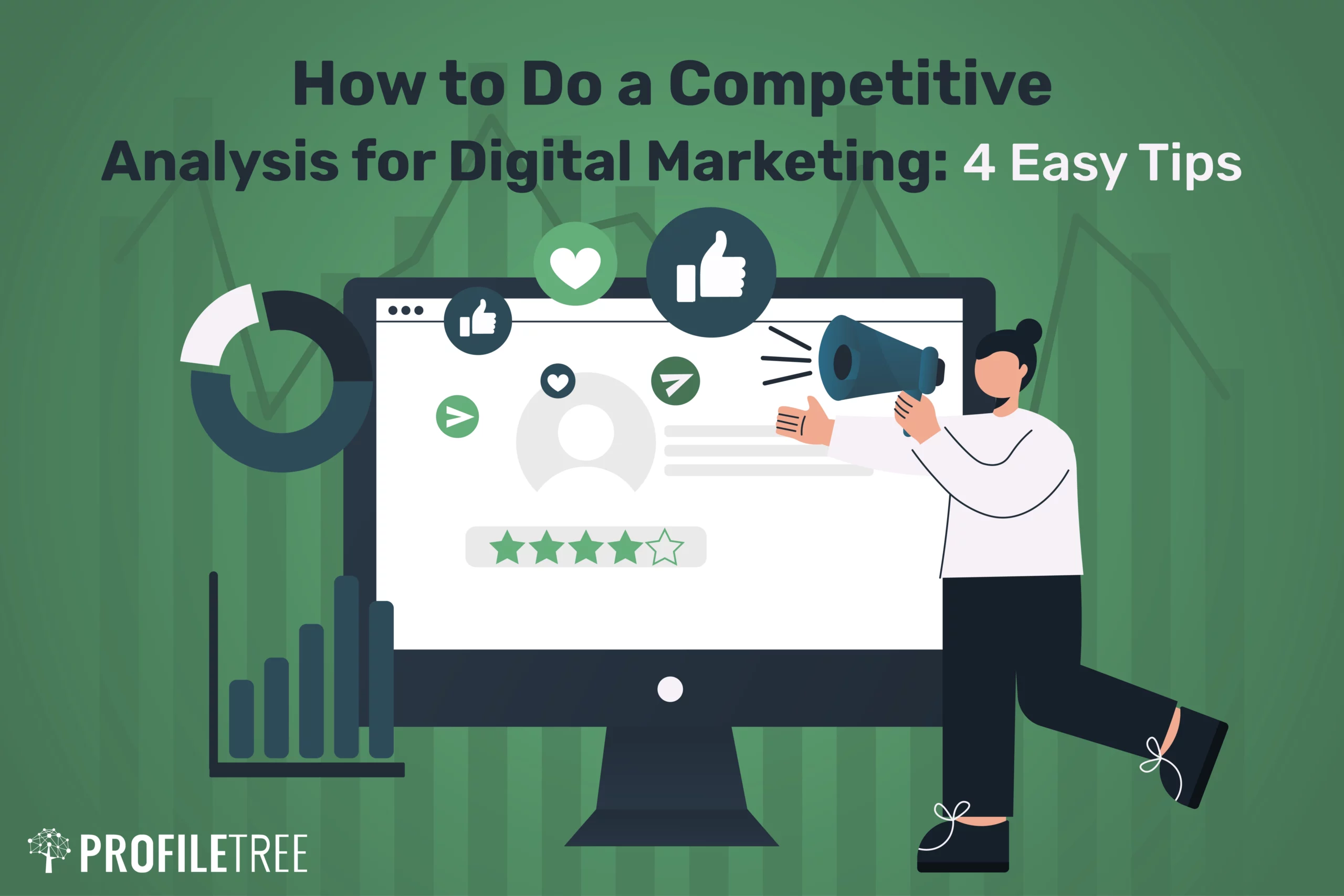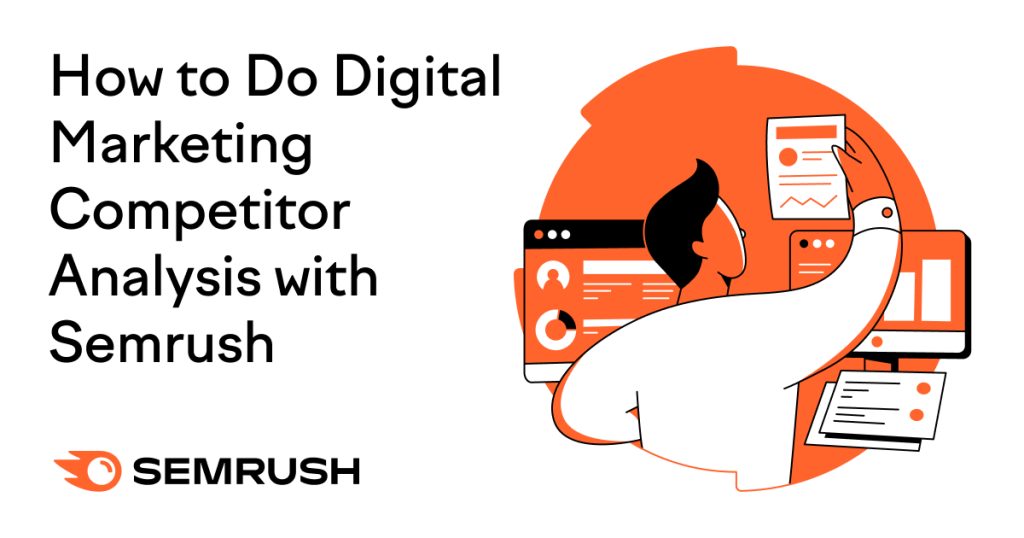To conduct a competitive analysis for digital marketing, identify your competitors and evaluate their strategies. Analyze their online presence, including website, SEO tactics, and social media engagement.
Understanding the landscape of digital marketing in your industry is crucial for standing out. A competitive analysis allows businesses to identify opportunities and threats in the digital space by closely examining what others are doing. This process involves digging into competitors’ online activities, from their search engine optimization (SEO) efforts to their social media marketing strategies.
By doing so, you gain insights into what works and what doesn’t, helping you refine your own digital marketing approach. A well-executed competitive analysis not only highlights your competitors’ strengths and weaknesses but also uncovers gaps in the market that your business can capitalize on. This proactive approach ensures your digital marketing efforts are always one step ahead, driving better results and fostering growth.
Introduction To Competitive Analysis In Digital Marketing
Understanding your rivals is key in digital marketing. This process is called competitive analysis. It helps you see what others are doing. This way, you can do better. Let’s dive into why this analysis is important and how it affects planning.
Purpose And Benefits
Knowing the competition has many perks. Here are some:
- Spot trends: See what’s popular in your field.
- Find gaps: Discover what others miss, then shine there.
- Learn from successes: Copy what works for others.
- Avoid mistakes: Learn what didn’t work for rivals.
- Sharpen your edge: Stand out by being unique.
Impact On Strategic Planning
Good planning starts with understanding the market. Here’s how competitive analysis helps:
- Set smart goals: Aim for what’s achievable and impactful.
- Pick strategies wisely: Choose tactics that work best.
- Allocate resources better: Spend time and money where it counts.
- Measure success accurately: Know what success looks like.
With these steps, your digital marketing plan can soar. You’ll know where to go and how to get there. Ready to outshine your rivals? Start with a thorough competitive analysis.
Identifying Your Digital Competitors
Identifying Your Digital Competitors is crucial for a strategic digital marketing plan. It allows you to understand the market. You learn from others’ successes and mistakes. Your digital competitors are not always obvious. They may not be your direct business rivals. They are entities that vie for the same online space and audience.
Tools For Competitor Discovery
Many tools can simplify the process of finding your digital competitors. These tools analyze data to reveal who competes for your keywords. They show who shares your audience.
- SEMrush: Offers comprehensive keyword data and competitor insights.
- Ahrefs: Helps to track competitors’ backlinks and keyword rankings.
- SimilarWeb: Provides traffic sources and audience overlap information.
- BuzzSumo: Identifies popular content and its creators in your niche.
Analyzing Market Presence
Determining the market presence of competitors involves several steps. You look at their digital footprint. This includes website traffic, search engine rankings, and social media engagement.
| Competitor | Website Traffic | SEO Ranking | Social Media Engagement |
|---|---|---|---|
| Competitor A | High | Top 5 | Very Active |
| Competitor B | Medium | Top 10 | Moderately Active |
| Competitor C | Low | Top 20 | Seldom Active |
Analyze the data to see where you stand. Use it to identify areas for improvement.
Evaluating Competitors’ Online Presence
Evaluating Competitors’ Online Presence is crucial in digital marketing. Understand what others in your niche are doing. Learn from their successes and missteps. This guides your strategy. Tailor your approach for better online visibility.
Website Analysis
Start by reviewing competitors’ websites. Look for layout, content quality, and user experience. A strong website attracts and retains customers. Note site speed, mobile-friendliness, and navigation. These factors influence search rankings and user satisfaction.
SEO plays a part too. Check for keyword usage, meta tags, and URLs. Use tools to understand their SEO strategies. This reveals their target audience and market positioning.
Examine their blog and resources section. High-value content drives traffic. It positions a brand as an industry leader. Observe the frequency and quality of their posts. Learn from their content strategy.
Social Media Activity
Social media platforms are key for brand interaction. Assess competitors’ social media profiles. Look at platforms they use. Identify where they engage their audience most.
Check post frequency and content type. Videos and images often outperform text. See what resonates with their followers. Engaging content can lead to high sharing rates.
Monitor likes, shares, and comments. Engagement metrics offer insights into content strategy. They reveal what works and what doesn’t. Use this to inform your social media plan.
Study their campaigns and hashtags. Successful campaigns can go viral. They increase brand visibility and customer engagement. Hashtags can amplify reach and categorize content.
Assessing Competitors’ Content Strategy
Understanding how rivals attract and engage their audience is key. Knowing this can improve your own content strategy. Let’s dive into how you can assess competitors’ content strategies effectively.
Content Quality And Engagement
Quality content keeps readers coming back. Look at your competitors’ blogs, videos, and social media. Are their articles well-researched and insightful? Is their video content professionally produced? Check for:
- Readability: Simple language wins readers.
- Originality: Unique content stands out.
- Visuals: Images and videos can boost engagement.
- Comments and Shares: High numbers suggest good engagement.
Tools like BuzzSumo can show you which content performs best. This insight helps tailor your approach.
Seo Tactics And Keyword Usage
SEO helps content rank higher on search engines. Analyze competitors’ use of keywords. Do they rank for the same keywords you target? Look for:
- Keyword Density: Too many can hurt rankings.
- Meta Descriptions: They should be clear and compelling.
- Headings: Proper use can improve readability for search engines.
- Backlinks: These can signal content authority.
SEO tools like SEMrush or Ahrefs can help analyze these factors. Use this data to enhance your own SEO strategy.
Analyzing User Experience And Customer Journey
Analyzing User Experience and Customer Journey is a critical component of competitive analysis in digital marketing. It helps understand how potential customers interact with competitors’ digital platforms. This analysis can reveal strengths to emulate or weaknesses to exploit. Let’s dive into the specifics of website navigation, interface, and conversion paths.
Website Navigation And Interface
A website’s navigation and interface are the backbone of user experience. A seamless interface leads to satisfied visitors. It encourages them to explore more content. Here are key points to evaluate:
- Layout clarity: Is the information well-organized?
- Menu simplicity: Can users find what they need quickly?
- Mobile responsiveness: Does the site work on all devices?
- Load time: Are pages loading fast enough?
Compare these factors with competitors to identify areas for improvement.
Conversion Paths And Funnels
Conversion paths are the steps a user takes to complete a goal. Well-designed funnels guide users smoothly from one step to the next. Here’s how to analyze this:
- Identify the starting point of the journey.
- Track the steps towards conversion.
- Spot any drop-off points.
Look for bottlenecks where users might get stuck. Comparing these paths with competitors can highlight opportunities for optimization. Aim for a frictionless journey to boost conversions.
Social Media Competitive Analysis
Social Media Competitive Analysis is key in digital marketing. It helps you see what others do well. This shows you ways to improve your strategy.
Engagement Rates And Audience Growth
Engagement rates and audience growth are crucial. They tell you how much people interact with content. They also show how fast a page gains followers.
| Metrics | Your Page | Competitor A | Competitor B |
|---|---|---|---|
| Engagement Rate | 5% | 4% | 6% |
| Audience Growth | 10% | 8% | 12% |
Compare these numbers. Learn from pages that grow fast and engage more.
Campaigns And Influencer Partnerships
Campaigns and influencer partnerships can boost your brand. Check what campaigns your rivals run. See who they partner with.
- Identify successful campaigns.
- Look at the influencers they work with.
- See how these partnerships help them.
This insight lets you make better campaign choices. It helps find good influencer partners too.
Paid Advertising Analysis
Understanding competitors’ paid advertising helps you outperform them. A detailed analysis reveals their strategies and spend efficiency. Let’s explore how to dissect their paid advertising efforts.
Ad Spend And Roi
Start by analyzing competitors’ ad spend. High spend can indicate strong market presence. Yet, ROI tells the success story. Check their cost-per-click (CPC) and conversion rates. This data shows if they’re spending wisely.
Use tools like SpyFu or SEMrush to estimate their budgets. Look for trends over time. Are they spending more on certain days or seasons? This info can guide your own budgeting.
Creative Strategies And Ad Platforms
Examine the creativity behind your competitors’ ads. Visuals and messaging impact performance. Notice the emotions they target. Do they use humor, fear, or inspiration?
Identify which platforms they favor. Are they on Google, Facebook, or LinkedIn? Each platform serves different audiences. Align your strategy to reach your audience where they are.
| Platform | Competitor | Ad Types | Engagement |
|---|---|---|---|
| Brand A | Search Ads | High Clicks | |
| Brand B | Video Ads | Many Shares | |
| Brand C | Sponsored Content | Strong Leads |
Break down their ad types. Are they using text, images, or videos? Match their ad types with engagement metrics. High engagement often means content resonates well.
Finally, assess their calls-to-action (CTAs). Strong CTAs drive consumer action. Weak ones lose interest. Learn from their CTAs to refine your own.

Credit: blog.hubspot.com
Email Marketing Strategies Of Competitors
Email Marketing Strategies of Competitors play a crucial role in digital marketing success. Understanding how your rivals engage their audience can reveal much. Let’s dive into their newsletter content, frequency, and personalization tactics.
Newsletter Content And Frequency
Start by subscribing to competitors’ newsletters. Track the topics they cover. Note the types of content: educational, promotional, or news-focused. Do they use eye-catching images or infographics? Record how often they send emails. Is it daily, weekly, or monthly? This data helps benchmark your email campaigns.
Segmentation And Personalization Techniques
Personalized emails stand out. They make customers feel special. Look for signs of segmentation in competitors’ emails. Do they address you by name? Are the emails tailored to your interests or past purchases? This level of detail can significantly boost engagement rates. Aim to decode their segmentation strategy to refine your own.
| Competitor | Content Type | Frequency | Personalization Level |
|---|---|---|---|
| Brand A | Promotional | Weekly | High |
| Brand B | Educational | Bi-Weekly | Medium |
| Brand C | News | Monthly | Low |
- Assess the value provided in each email.
- Identify call-to-action placements.
- Examine subject lines for effectiveness.
- Subscribe to competitor newsletters.
- Analyze content type and send frequency.
- Investigate segmentation and personalization.
Leveraging Competitors’ Reviews And Feedback
Understanding your competitors is crucial in digital marketing.
One goldmine of insight is competitors’ reviews and feedback.
These can unlock strategies to outshine your rivals.
Customer Sentiment Analysis
Customer reviews reveal much about a brand’s perception.
Analyze these reviews to gauge customer sentiment.
Tools like sentiment analysis software can help.
- Identify common praises and complaints.
- Spot trends in customer feedback.
- Understand the emotional tone behind reviews.
Service Improvement Opportunities
Feedback can spotlight areas for your business growth.
It can show where competitors may be falling short.
| Competitor’s Weakness | Your Opportunity |
|---|---|
| Poor customer service | Invest in training your team |
| Slow shipping | Offer faster delivery options |
| High prices | Introduce competitive pricing |
Use this data to refine your services and products.
Always aim to turn your competitor’s weaknesses into your strengths.
Developing Your Own Competitive Edge
Developing your own competitive edge is crucial in the digital marketing arena. To stand out, you need to analyze what others do and then go further. Let’s explore ways to sharpen your edge.
Innovative Digital Marketing Tactics
Staying ahead calls for innovation. Use these tactics:
- Interactive content: Quizzes and polls engage users.
- Personalization: Tailor experiences to user preferences.
- Video marketing: Create compelling stories via video.
- AI and automation: Use chatbots for instant customer service.
These tactics make your brand memorable.
Continuous Monitoring And Adaptation
Success in digital marketing is not static. It requires vigilance and flexibility. Adopt these practices:
- Analyze data: Keep tabs on campaign performance.
- SEO trends: Update strategies with algorithm changes.
- Social listening: Adjust tactics based on audience feedback.
- Competitive analysis: Regularly compare with rivals.
This approach ensures you stay on top.
Conclusion: Implementing Insights From Analysis
Conclusion: Implementing Insights from Analysis is crucial. It turns data into action. Your digital marketing can soar with the right steps. Let’s dive into making your strategy unbeatable.
Actionable Steps For Your Strategy
- Identify your top competitors’ strengths and weaknesses.
- Focus on unique selling points (USPs) that set you apart.
- Use SEO tools to uncover keyword gaps and opportunities.
- Adapt your content strategy to engage your target audience better.
- Optimize your website and content for better user experience.
- Adjust your ad spending based on competitor analysis.
Measuring Success And Making Adjustments
- Set clear goals and KPIs to track progress.
- Use analytics tools to monitor traffic, engagement, and conversion rates.
- Regularly review your strategy and adapt based on performance data.
- Test different approaches in small scales before full implementation.
- Keep an eye on competitors for new tactics and adjust accordingly.
Remember, the goal is continuous improvement. Your digital marketing strategy should evolve. Stay ahead by implementing insights and measuring success.

Credit: profiletree.com

Credit: talentport.com
Frequently Asked Questions
How To Do Digital Marketing Competitor Analysis?
To conduct a digital marketing competitor analysis, start by identifying your main competitors. Analyze their online presence, including websites and social media. Review their SEO strategies, content, and engagement tactics. Monitor their advertising efforts and customer interactions. Use tools like SEMrush or Ahrefs for deeper insights.
What Is Digital Competitive Analysis?
Digital competitive analysis is a process that evaluates online strengths and weaknesses compared to competitors to identify business opportunities and threats.
How To Do A Competitive Marketing Analysis?
Identify your competitors and gather data on their strategies, strengths, and weaknesses. Analyze their market positioning, product offerings, and customer feedback. Compare their online presence, SEO tactics, and social media engagement with your own. Use this insight to refine your marketing strategy.
How To Do A Digital Marketing Analysis?
Begin with a comprehensive audit of your current digital presence. Identify key performance indicators (KPIs) and use tools to analyze website traffic, SEO effectiveness, social media engagement, and competitor strategies. Adjust your digital marketing plan based on these insights.
What Is Competitive Analysis In Digital Marketing?
Competitive analysis in digital marketing involves assessing competitors’ strategies, strengths, weaknesses, and market presence to identify opportunities and threats.
Why Conduct A Competitive Analysis?
Conducting a competitive analysis helps to benchmark against rivals, find gaps in the market, and refine your strategy to gain a competitive edge.
What Steps Are Involved In Competitive Analysis?
Key steps include identifying competitors, analyzing their online presence, evaluating their marketing strategies, and monitoring their performance metrics.
Which Tools Can Assist In Competitive Analysis?
Tools like SEMrush, Ahrefs, and BuzzSumo provide insights into competitors’ SEO, content, and social media strategies.
Conclusion
Embarking on competitive analysis can transform your digital marketing strategy. By understanding rivals, you uncover growth opportunities and sharpen your edge. Remember, regular analysis ensures you stay ahead. Embrace these insights and steer your brand towards uncharted success in the digital realm.


